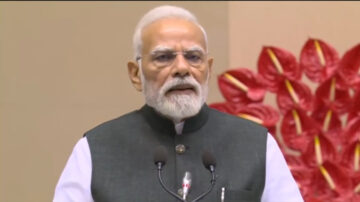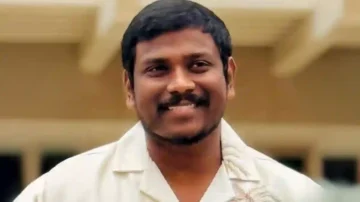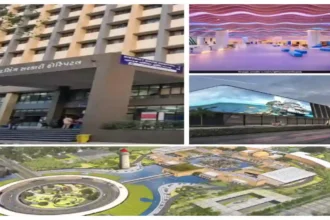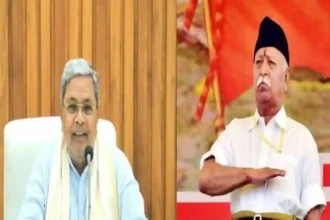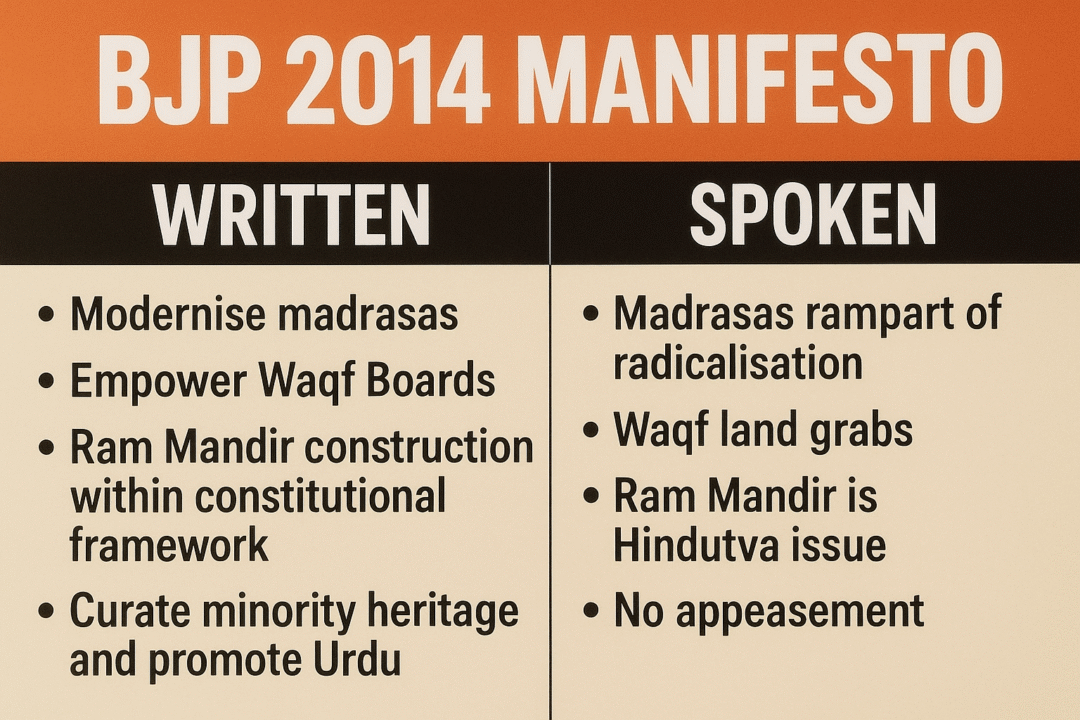
When the Bharatiya Janata Party (BJP) campaigned for the 2014 Lok Sabha elections under Narendra Modi’s leadership, its speeches and slogans promised a decisive break from decades of “appeasement politics.” The rhetoric on the ground was unmistakably framed around Hindu pride, Ram Mandir, and Hindu unity.
- Caste Politics: Hindu Unity or Hindu Fragmentation?
- The Madrasa Modernisation Promise
- Waqf Boards: Empowerment vs. “Land Jihad”
- Ram Mandir: Constitutional Framework vs. Political Mobilisation
- Uniform Civil Code (UCC): Written Promise, Political Tool
- Inclusive Language for Minorities
- Economic Promises vs. Religious Campaigning
- The Pattern of Double Speak
- Conclusion: The Hindu Rashtra Myth vs. Written Reality
Yet, a closer reading of the BJP’s official 2014 Election Manifesto reveals a very different document: one that leaned heavily on caste based promises, pledged special funds for minorities, and committed to strengthening the very institutions the party and its supporters often denounce in public.
This contrast raises a critical question: was the manifesto deliberately crafted as a moderate, inclusive document for official record, while the campaign narrative was built on polarising religious rhetoric to galvanise votes?
Caste Politics: Hindu Unity or Hindu Fragmentation?
The BJP frequently positions itself as the party of “Hindu ekta”, projecting itself as the vehicle for a united Hindu society and a future “Hindu Rashtra.”
However, the manifesto dedicates extensive sections to SC, ST, OBC, and tribal-specific welfare schemes:
Mission mode projects for housing, education, skills, and healthcare for SC/ST/OBC communities.
A new Van Bandhu Kalyan Yojna for tribal development.
Strong emphasis on “social justice” and “eradicating untouchability and manual scavenging.”
While these promises may sound progressive, they also reinforce caste divisions within Hindu society. Nowhere does the manifesto seriously address the aspirations of the General Category Hindus, except a brief mention of the so-called “neo-middle class” — those who had risen out of poverty but not yet stabilized.
This omission shows how BJP’s official blueprint continues quota-driven politics and identity based appeasement, even as its leaders denounce “vote bank politics” in public.
SC/ST/OBC (Caste Welfare)
“Eradication of untouchability and manual scavenging will be our prime focus.”
“Special housing, education, skills development and health schemes will be launched for SCs, STs, OBCs and other weaker sections of society.”
“A ‘Van Bandhu Kalyan Yojna’ with a mission approach will be launched for the welfare of tribals.”
The Madrasa Modernisation Promise
Strengthen and modernize minority educational systems and institutions; dovetailing them with modern requirements. National Madrasa modernization programme would be initiated.
One of the most striking contradictions lies in the BJP’s treatment of madrasas.
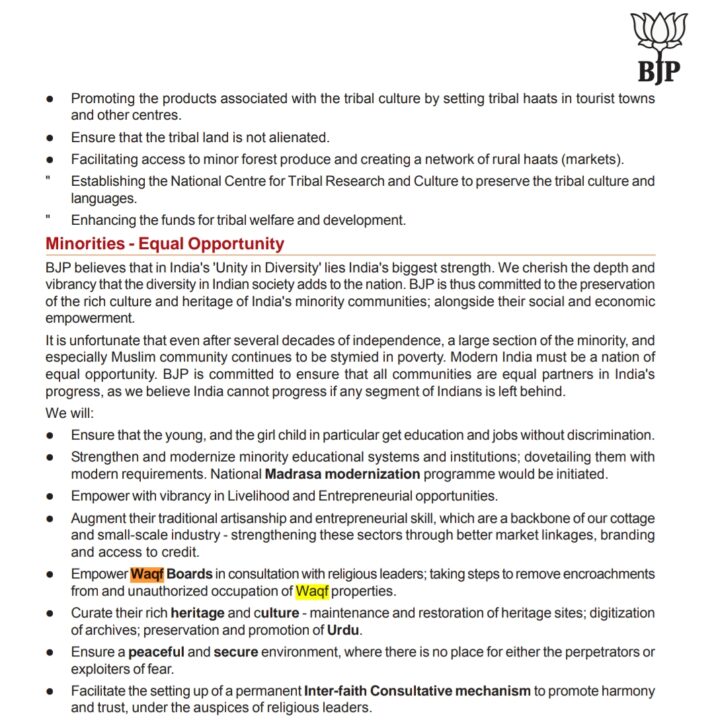
Manifesto commitment:
“Strengthen and modernize minority educational systems and institutions; dovetailing them with modern requirements. National Madrasa modernization programme would be initiated.”
Public rhetoric:
Senior BJP leaders have repeatedly claimed that madrasas are “hubs of radicalisation,” with some even calling for their closure.
The manifesto, however, allocated more support and funding for these institutions instead of prioritising the mainstream integration of Muslim youth into the national education system.
This duality reveals a clear political double-speak: appearing moderate and reformist in print, while projecting hardline positions on the campaign trail.
Waqf Boards: Empowerment vs. “Land Jihad”
Empower Waqf Boards in consultation with religious leaders; take steps to remove encroachments from and unauthorized occupation of Waqf properties.
Another major fault line is BJP’s stand on Waqf Boards, which manage mosque lands and other Muslim charitable properties.
Manifesto pledge: “Empower Waqf Boards in consultation with religious leaders; take steps to remove encroachments from and unauthorized occupation of Waqf properties.”
Public discourse: BJP leaders and affiliates frequently accuse Waqf Boards of being the “biggest landowners after the government,” often linked to illegal land grabs and corruption.
Instead of promising structural reform or abolition, the manifesto aimed at strengthening Waqf Boards a commitment completely at odds with the party’s speeches against Waqf’s alleged encroachment empire.
Ram Mandir: Constitutional Framework vs. Political Mobilisation
The BJP manifesto cautiously stated:
BJP will facilitate the construction of the Ram Temple in Ayodhya within the constitutional framework.
This restrained language contrasts with the emotionally charged speeches in rallies, where the party and allied organisations framed the Ram Mandir issue as a question of Hindu identity and justice.
The eventual construction of the Ram Mandir only followed the Supreme Court’s 2019 verdict a legal outcome rather than the political will expressed in the manifesto.
Here again, the gap between manifesto and mobilisation is stark: cautious wording for the record, fiery rhetoric for the masses.
Uniform Civil Code (UCC): Written Promise, Political Tool
The manifesto unambiguously promised the implementation of a Uniform Civil Code to ensure equality and gender justice.
Ten years later, the UCC has not been implemented nationwide. Instead, it has remained a recurring theme in speeches to polarise voters, often framed against Muslims and their personal laws.
This makes the UCC pledge more of a campaign instrument than a serious policy roadmap.
Inclusive Language for Minorities
The manifesto devotes an entire section to Minorities Equal Opportunity, pledging:Education and jobs for minority youth, especially Muslim girls.
Curating Muslim heritage, Urdu promotion, and restoration of minority sites.
Establishment of interfaith consultative mechanisms to foster harmony.
In other words, the BJP’s written promises in 2014 sound remarkably similar to what Congress had often been accused of: minority appeasement.
Yet, BJP’s public campaign narrative was built on blaming Congress and regional parties for “appeasement politics.”
Minorities – Equal Opportunity
“It is unfortunate that even after several decades of independence, a large section of the minority, and especially Muslim community continues to be stymied in poverty. Modern India must be a nation of equal opportunity.”
“We will curate their rich heritage and culture – maintenance and restoration of heritage sites; digitization of archives; preservation and promotion of Urdu.”
“Facilitate the setting up of a permanent Inter-faith Consultative mechanism to promote harmony and trust, under religious leaders of all faiths.”
Economic Promises vs. Religious Campaigning
Another layer of contradiction lies in priorities:
- Manifesto core: Economic revival, fighting corruption, bringing back black money, creating jobs, and improving infrastructure.
- Campaign focus: Hindu pride, Muslim appeasement charges, love jihad, cow protection, and Hindu-Muslim faultlines.
This mismatch suggests that religious identity politics was used to win votes, while the official document maintained a “development first” posture for credibility with institutions and international observers.
The Pattern of Double Speak
- On Paper (Manifesto): Secular, inclusive, caste and minority conscious, development driven.
- On Stage (Public Speeches): Communal, polarising, Hindu-first, anti-minority.
This double strategy allowed BJP to project moderation in official forums (Election Commission, global scrutiny) while simultaneously mobilising voters through polarisation on the ground.
Conclusion: The Hindu Rashtra Myth vs. Written Reality
The 2014 manifesto shows that BJP, despite projecting itself as the party of Hindus and Hindu unity, continued caste divisions, promised funds to madrasas, empowered Waqf Boards, and preserved minority heritage — all while rallying voters under the banner of Hindu Rashtra.
This contrast between written commitments and spoken narratives highlights a calculated political hypocrisy:
- To institutions and observers, BJP presents itself as a responsible, inclusive party.
- To voters, it mobilises majoritarian sentiment by promising Hindu pride and attacking the very institutions it pledged to support in writing.
For the Hindu voter expecting the 2014 manifesto to lay the foundation of Hindu Rashtra, the document tells a different story: a blend of caste appeasement, minority welfare, and cautious religious symbolism.
The gap between what BJP wrote and what BJP spoke is perhaps the clearest evidence of its two-faced political strategy — one for the record, another for the crowd.


